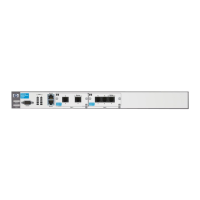2-58
Controlling Management Access to the ProCurve Secure Router
Using SNMP to Manage the ProCurve Secure Router
In both examples, the users that you assign to the groups (using the
snmp-server user command) will have the access to views that are specified
in the respective snmp-server group commands.
You can also create more than one entry for the same group using different
SNMP versions or v3 security options. For example, you could use views to
limit the access of Admins who use the less secure SNMP v2c, entering:
ProCurve(config)# snmp-server group Admins v2 read view3 write view4
Use the no form of the command to remove a specified group.
Syntax: no snmp-server group <groupname>
Configure SNMP Users
You use the snmp-server user command to create users who can access
SNMP information. There are several ways to enter this command. If you want
to configure a user on the ProCurve Secure Router, enter the following
command from the global configuration mode context:
Syntax: snmp-server user <username> <groupname> [v1 | v2c | v3 {auth [md5 | sha]
<password>} | {priv des <password>}] [access <listname>]
If you want to grant access to a user that is configured on a remote SNMP
server, enter the following command from the global configuration mode
context:
Syntax: snmp-server user <username> <groupname> [remote <SNMP server
address>] [v3 {auth [md5 | sha] <password>} {priv des <password>}] [access
<listname>]
Note When entering the snmp-server user command, you can include multiple
options. If you want to use the access option to specify an ACL, you must
enter this option last.
Table 2-12 lists the options for the snmp-server user command.

